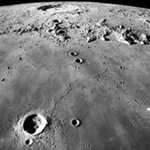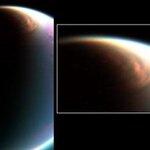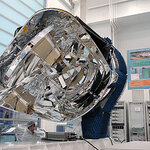Space

Light has been shed on the dark parts of the Moon with experiments by University of Edinburgh researchers simulating billions of years of lunar evolution.
It is generally believed the Moon was created after an early, semi molten, Earth collided with a planet the size of Mars.
The collision was so great that the orbiting debris would have formed a so-called lunar magma ocean, or liquefied rock, up to several hundred kilometres deep that would have covered the Moon's surface.
Yet until now, it has remained a mystery as to how this magma ocean cooled and how the lunar landscape evolved into…

A giant elliptical galaxy seen in an image from the Hubble Space Telescope is the closest gravitational lens yet known, according to information released by the Hubble Heritage Project Tuesday (Feb. 6).
John Blakeslee, an assistant professor with the Department of Physics and Astronomy at Washington State University, working with colleagues from the University of Hawaii and the University of Durham in England, targeted the galaxy for a closer look by Hubble.
Elliptical Galaxy ES) 325-G004 in the Abell Cluster S0740. (Credit: NASA, ESA, and The Hubble Heritage Team (STScI/AURA) /…

A giant cloud half the size of the United States has been imaged on Saturn’s moon Titan by the Cassini spacecraft. The cloud may be responsible for the material that fills the lakes discovered last year by Cassini's radar instrument.
Cloaked by winter's shadow, this cloud has now come into view as winter turns to spring. The cloud extends down to 60 degrees north latitude, is roughly 2400 kilometers in diameter and engulfs almost the entire north pole of Titan.
The new image was acquired on 29 December 2006, by Cassini's visual and infrared mapping spectrometer (VIMS). Scientific models…

The House Appropriations Committee has passed its version of the 2007 federal government budget. In it, funding for NASA was cut by $550 million (approximately 3.2%) from the amount proposed by the Bush Administration last February.
S.O.S. Save Our Science Campaign Button. Credit: The Planetary Society
The $16.2 billion budgeted for NASA for 2007 is the same as the amount approved for 2006. To become law, the Appropriations Committee's proposal still must be approved by the full House and Senate.
The Planetary Society strongly opposed the Administration's request for fiscal year 2007…

ESA’s Planck satellite, due to study relic radiation from the Big Bang, is on display for the media tomorrow in Cannes.
Credits: ESA-S. Corvaja
Planck will make the most accurate maps yet of the microwave background radiation that fills space. It will be sensitive to temperature variations of a few millionths of a degree and will map the full sky in nine wavelengths.
The immediate outcome of the Big Bang and the initial conditions for the evolution in the universe’s structure are the primary target of this important mission. From the results, a great deal more will be learnt not only about…

The powerful vision of NASA's Hubble Space Telescope has allowed astronomers to study for the first time the layer-cake structure of the atmosphere of a planet orbiting another star. Hubble discovered a dense upper layer of hot hydrogen gas where the super-hot planet's atmosphere is bleeding off into space.
This artist's illustration shows an extrasolar planet orbiting very close to its host star. The planet designated HD 209458b, is about the size of Jupiter. Unlike Jupiter, the planet is so hot that its atmosphere is "puffed up." Starlight is heating the planet's atmosphere, causing hot…

Astronomers using the Subaru telescope in Hawaii have looked 60 million years further back in time than any other astronomers, to find the most distant known galaxy in the universe. In doing so, they are upholding Subaru's record for finding the most distant and earliest galaxies known. Their most recent discovery is of a galaxy called I0K-1 that lies so far away that astronomers are seeing it as it appeared 12.88 billion years ago.
This discovery, based on observations made by Masanori Iye of the National Astronomical Observatory of Japan (NAOJ), Kazuaki Ota of the University of Tokyo,…

A research team at Swarthmore College discovered a previously unknown companion to the bright star, beta Crucis, in the Southern Cross. As a prominent member of the well-known constellation Crux, or the Southern Cross, it appears on five national flags: Australia, Brazil, New Zealand, Papua New Guinea, and Samoa. The discovery was announced at the American Astronomical Society meeting held in Seattle January 5-10.
Clockwise, the Southern Cross is prominently displayed on Australia's flag, with beta Crucis just right of the Union Jack; an optical image of the Southern Cross, with beta Crucis…

The European Space Agency's gamma ray observatory Integral has caught the centre of our galaxy in a moment of rare quiet. A handful of the most energetic high-energy sources surrounding the black hole at the centre of the Galaxy had all faded into a temporary silence when Integral looked.
This unusual event is allowing astronomers to probe for even fainter objects and may give them a glimpse of matter disappearing into the massive black hole at the centre of our galaxy. The Galactic centre is one of the most dynamic places in our Galaxy.
It is thought to be home to a…

When kids head back to school this fall, they might have some brand new planets to memorize.
The International Astronomical Union, currently meeting in Prague, is expected to vote on the definition of a planet. The organization, which has named planets and moons since it was founded in 1919, is debating a plan to establish that our solar system has 12 planets.
The designated dozen would include eight of the traditional nine -- Mercury, Venus, Earth, Mars, Jupiter, Saturn, Uranus, and Neptune -- plus Ceres, the largest known asteroid. Pluto would still be a planet, but in a…